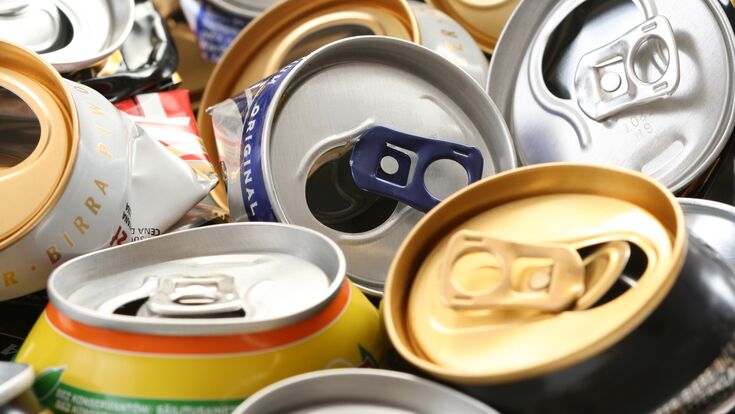Interview beverage can recycling : Maarten Labberton: "We are confident to achieve 100 percent aluminium can recycling by 2030"

A new report commissioned by Metal Packaging Europe and European Aluminium shows that the overall recycling rate for aluminium beverage cans in the European Union, UK, Switzerland, Norway and Iceland remained high in 2020 at almost 73% - despite the new EU recycling reporting rules. These require the member states to report at the point of entrance of a recycling facility, instead of the collection phase. Most EU member states already adhere to the new rules.
This of course has led to a drop in recycling for most packaging materials. This is true for aluminium as well as it drops 3% compared to 2019. At the same time there was an increase of 9% in cans consumed which means the total amount of aluminium recycled from cans reached a record level of 510,000 tonnes, an increase of more than 20,000 tonnes since the previous year. According to the two organisations this represents a total Greenhouse Gas (GHG) emissions saving of 4,2 million tonnes of CO₂eq, equivalent to the amount of GHG emissions produced by a mid-sized European town like Toulouse or Gdansk.
Léonie Knox-Peebles, CEO of Metal Packaging Europe, said that the industry is fully supportive of the new EU recycling reporting rules as these measure ‘real’ recycling. “We are pleased to notice that this has resulted in only a very minor and likely only temporary drop in the can recycling rate. The aluminium beverage can already meets the highest recyclability performance grade of 95% as proposed in the new draft for a Packaging & Packaging Waste Regulation,’’ she said. “As aluminium beverage cans are fully circular and can be recycled endlessly without losing the aluminium’s inherent properties, we are confident that even in a growing market we will be able to meet our 100% beverage can recycling ambition by 2030.”
Even though the industry was surprised by the high reuse targets in the new EU proposal, they welcome the obligation to collect 90% or more of metal and plastic beverage containers for recycling, preferably via Deposit Return Systems (DRS), as Maarten Labberton, Director Packaging Group at European Aluminium said, calling upon those countries with classic EPR systems to invest more into the collection and sorting of the whole aluminium packaging fraction in order to fully close the material loop.
In our interview, Labberton talks about the reasons for the increase in can recycling, the industry meeting the EU targets and the necessity of regulations.
What are the key drivers for this increase in aluminium can recycling?
Investments in better collection and sorting of used aluminium packaging for recycling are clearly paying off. And thanks to awareness programmes like Every Can Counts, consumers are increasingly aware of the need to recycle their cans properly.
Last but not least, there are simply more aluminium cans on the market thanks to increased consumer demand as well as the continued shift from steel to aluminium beverage cans. These combined factors resulted in a growth of the market for aluminium beverage cans by 9% in 2020.
Could you specify?
There are two major reasons: 1) more and more countries turn to deposit return systems (DRS) for plastic and metal beverage containers. With DRS we can relatively easily increase our can collection and recycling rates to 90% or more and on top these streams are of excellent quality, perfectly fit for can-to-can remelting.

2) We see increased investments in advanced sorting technologies. More sorting centres install one or even two Eddy Current Separators (ECS). The ECS acts as a ‘magnet’ for non-ferrous metals like aluminium, rejecting and thus separating the aluminium from the other waste fractions. On top, sorting centres are investing in induction sensor sorters and robot sorters that can further boost the aluminium collected for recycling.
Compared to other beverage packaging materials: what sets aluminium cans apart?
Aluminium cans are fully recyclable, with no loss in quality, resulting in product circularity and significant carbon emissions reductions.[1]
Aluminium is a permanent material, which doesn’t degrade during recycling and keeps its inherent material characteristics, regardless the number of recycling trips. Unlike other beverage packaging materials, used aluminium cans are rarely subject to degradation, mechanical stress, or chemical damage in the recycling processes. It can take only 60 days for a single aluminium can to be produced, filled, distributed, consumed, and recycled into a new can. This makes the aluminium beverage can the ideal packaging solution for achieving the EU’s 2025 and 2030 recycling targets.
Unlike other beverage packaging materials, used aluminium cans are rarely subject to degradation, mechanical stress, or chemical damage in the recycling processes.Maarten Labberton
Absolutely! In fact, we want to go much further than the EU’s targets. That’s why together with Metal Packaging Europe we launched a joint Roadmap towards achieving 100% aluminium beverage can recycling by 2030. We are confident that we can achieve this ambitious target, but it will require the participation and support of the entire value chain. We call on policymakers and partners, including brand owners, retailers, consumers, packaging recovery organisations, and recyclers, to work with us in our mission to fully close the loop.
Do you think legislative initiatives like the proposed Packaging & Packaging Waste Regulation are necessary to improve recycling rates?
For sure! We are very pleased with the references in the new Packaging Regulation to the so-called recyclability performance grades and to DRS as the preferred instrument to reach 90% or more collection of beverage packaging. Aluminium already qualifies for the highest performance grade as it can be recycled with 95% or more in a closed material or even a product loop. In general, the EU Circular Economy legislation plays an important role in moving from a linear to a circular economy. In particular, we must ensure the full implementation and enforcement of existing EU waste legislation and introduce clear definitions of design for recycling and recyclability at scale, two key topics which the EU Commission needs to address in Delegated Acts within the next few years.
[1]Aluminium recycling requires 95% less energy than producing primary aluminium.


